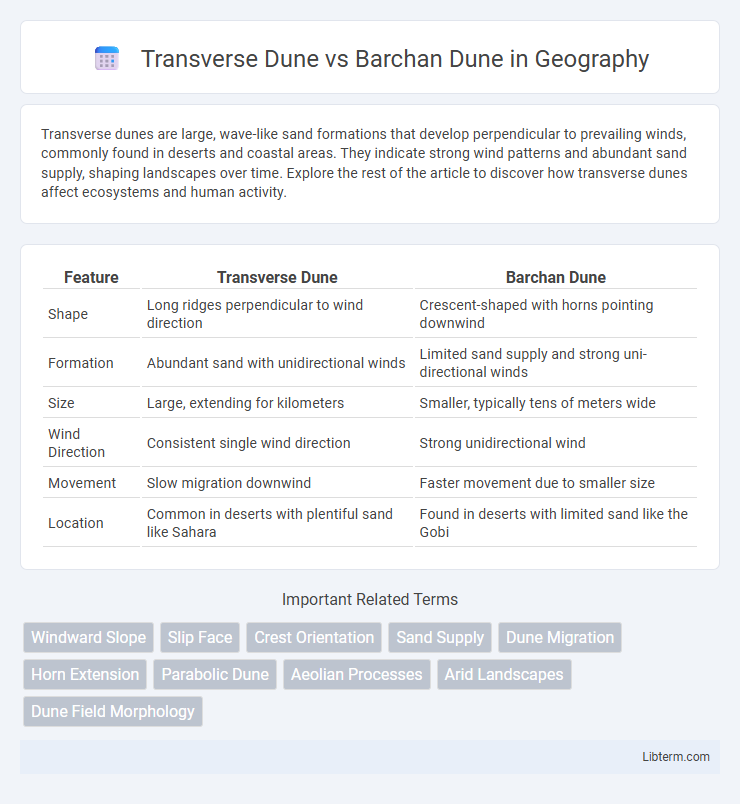Transverse dunes are large, wave-like sand formations that develop perpendicular to prevailing winds, commonly found in deserts and coastal areas. They indicate strong wind patterns and abundant sand supply, shaping landscapes over time. Explore the rest of the article to discover how transverse dunes affect ecosystems and human activity.
Table of Comparison
| Feature | Transverse Dune | Barchan Dune |
|---|---|---|
| Shape | Long ridges perpendicular to wind direction | Crescent-shaped with horns pointing downwind |
| Formation | Abundant sand with unidirectional winds | Limited sand supply and strong uni-directional winds |
| Size | Large, extending for kilometers | Smaller, typically tens of meters wide |
| Wind Direction | Consistent single wind direction | Strong unidirectional wind |
| Movement | Slow migration downwind | Faster movement due to smaller size |
| Location | Common in deserts with plentiful sand like Sahara | Found in deserts with limited sand like the Gobi |
Introduction to Transverse and Barchan Dunes
Transverse dunes form in areas with abundant sand and consistent wind direction, characterized by long, wave-like ridges perpendicular to the wind. Barchan dunes develop in regions with limited sand supply and unidirectional winds, featuring crescent-shaped dunes with horns pointing downwind. Both dune types illustrate sediment transport and wind dynamics, essential for understanding desert geomorphology.
Formation Processes of Dune Types
Transverse dunes form in areas with abundant sand supply and steady wind direction, causing sand to accumulate in long ridges perpendicular to the wind. Barchan dunes develop where sand is limited and wind blows consistently from one direction, resulting in crescent-shaped dunes with tips pointing downwind. The key distinction lies in sediment availability and wind consistency, influencing their unique morphological patterns.
Key Characteristics of Transverse Dunes
Transverse dunes are large, linear formations characterized by their ridge-like shape perpendicular to prevailing wind directions, typically formed in environments with abundant sand supply and unidirectional winds. Unlike barchan dunes, which are crescent-shaped and formed in areas with limited sand, transverse dunes have continuous, wave-like crests that can extend for kilometers. Their key characteristics include a broad, gently sloping windward side and a steep leeward slip face, promoting their stability and growth in sand-rich desert regions.
Key Characteristics of Barchan Dunes
Barchan dunes are crescent-shaped sand formations characterized by their curved horns pointing downwind, typically found in areas with a unidirectional wind pattern and limited sand supply. These dunes move quickly over hard surfaces due to their steep slip face on the leeward side, which facilitates sand avalanches. In contrast to transverse dunes, which form large, continuous ridges perpendicular to the wind, barchan dunes remain isolated and smaller, reflecting their adaptation to specific wind dynamics and sand availability.
Differences in Shape and Structure
Transverse dunes feature broad, wave-like ridges that run perpendicular to prevailing winds, forming extensive, connected dune fields with relatively consistent height. Barchan dunes have a distinct crescent shape with tips pointing downwind, typically isolated and smaller in size, formed in areas with limited sand supply. The structural difference lies in transverse dunes' elongated ridges versus barchan dunes' individual, curved horns, reflecting variations in sand availability and wind patterns.
Wind Patterns Influencing Dune Formation
Transverse dunes form perpendicular to consistent, strong wind patterns where abundant sand supply exists, creating long ridges parallel to prevailing winds. In contrast, barchan dunes develop in areas with limited sand and unidirectional winds, shaping crescentic dunes with tips pointing downwind. Variations in wind velocity and direction critically dictate the morphology and orientation of these distinct dune types.
Locations Where Each Dune Type Occurs
Transverse dunes predominantly form in areas with abundant sand supply and consistent wind direction, such as the Sahara Desert and the Namib Desert. Barchan dunes typically arise in regions with limited sand availability and unidirectional winds, commonly found in the Gobi Desert and the central Great Basin of the United States. Both dune types illustrate how wind patterns and sand volume influence their distinct geographical distribution.
Ecological and Environmental Impacts
Transverse dunes, formed in areas with abundant sand and consistent wind direction, often create extensive habitats for specialized flora and fauna, promoting biodiversity but potentially leading to soil destabilization if vegetation is lost. Barchan dunes, shaped by limited sand supply and unidirectional winds, migrate rapidly, which can disrupt local ecosystems and human activities by burying vegetation and altering water availability. Both dune types influence microclimates, soil composition, and erosion patterns, affecting regional ecological balance and land use sustainability.
Significance in Geomorphology and Research
Transverse dunes and barchan dunes play crucial roles in geomorphology as indicators of wind patterns and sediment availability in arid environments. Transverse dunes, characterized by their long ridges perpendicular to prevailing winds, signify abundant sand supply, whereas barchan dunes, crescent-shaped with horns pointing downwind, indicate limited sediment and unidirectional winds. Research on these dunes enhances understanding of sediment transport dynamics, desertification processes, and climate change impacts on desert landscapes.
Summary: Comparing Transverse and Barchan Dunes
Transverse dunes form large, continuous ridges perpendicular to prevailing winds, typically found in areas with abundant sand supply, while barchan dunes are crescent-shaped and develop in regions with limited sand and unidirectional winds. Transverse dunes can span several kilometers, creating extensive dune fields, whereas barchan dunes are smaller, isolated, and migrate faster due to their shape and wind dynamics. Both types highlight distinct aeolian processes and sand availability, serving as indicators of desert wind regimes and sediment budgets.
Transverse Dune Infographic

 libterm.com
libterm.com